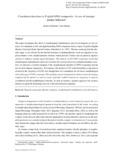Citation link:
http://dx.doi.org/10.25819/ubsi/10520| DC Field | Value | Language |
|---|---|---|
| crisitem.author.orcid | 0000-0003-1157-1696 | - |
| crisitem.author.orcid | 0000-0002-4092-8933 | - |
| dc.contributor.author | Schebesta, Annika | - |
| dc.contributor.author | Kunter, Gero | - |
| dc.date.accessioned | 2024-10-09T06:39:45Z | - |
| dc.date.available | 2024-10-09T06:39:45Z | - |
| dc.date.issued | 2022 | de |
| dc.description.abstract | This paper investigates the effect of morphological embeddedness and lexical frequency on the duration of constituents in left- and right-branching NNN compounds from a corpus of spoken English (Boston University Radio Speech Corpus, Ostendorf et al. 1997). Theories assuming that the phonetic signal is not affected by the internal structure of multimorphemic words are opposed by empirical studies on the morpho-phonetic interface which provide evidence that the phonetic signal is sensitive to different morphological boundaries. The analysis of 465 NNN compounds reveals that morphological embeddedness alone does not have the expected effect on constituent durations, however, we detected a complex interplay of the morphological structure of NNN compounds and the two involved bigram frequencies. For instance, the duration of N2 in left-branching compounds is affected by the frequency of N2N3 even though these two constituents do not form a morphological unit in this type of NNN compound. This interplay may be interpreted as a strategic way employed by the speaker in order to resolve potential conflicts between the frequency of adjacent constituents and the morphological structure: In such an instance, speakers appear to use acoustic duration to signal the branching direction of the triconstituent compound. | en |
| dc.identifier.doi | http://dx.doi.org/10.25819/ubsi/10520 | - |
| dc.identifier.uri | https://dspace.ub.uni-siegen.de/handle/ubsi/2733 | - |
| dc.identifier.urn | urn:nbn:de:hbz:467-27331 | - |
| dc.language.iso | en | de |
| dc.relation.hasversion | Accepted manuscript | de |
| dc.rights | Attribution-NonCommercial-NoDerivatives 4.0 International | * |
| dc.rights.uri | http://creativecommons.org/licenses/by-nc-nd/4.0/ | * |
| dc.source | Journal of Phonetics ; Volume 94, 101164. - https://doi.org/10.1016/j.wocn.2022.101164 | de |
| dc.subject.ddc | 400 Sprache, Linguistik | de |
| dc.subject.other | English compounds | en |
| dc.subject.other | Phonetic reduction | en |
| dc.subject.other | Morphological embeddedness | en |
| dc.subject.other | Lexical frequency | en |
| dc.subject.other | Englische Verbindungen | de |
| dc.subject.other | Phonetische Reduktion | de |
| dc.subject.other | Morphologische Einbettung | de |
| dc.subject.other | Lexikalische Häufigkeit | de |
| dc.title | Constituent durations in English NNN compounds: A case of strategic speaker behavior? | en |
| dc.type | Article | de |
| item.fulltext | With Fulltext | - |
| ubsi.origin.dspace5 | 1 | - |
| ubsi.publication.affiliation | Seminar für Anglistik | de |
| ubsi.source.doi | 10.1016/j.wocn.2022.101164 | - |
| ubsi.source.issn | 1095-8576 | - |
| ubsi.source.issn | 0095-4470 | - |
| ubsi.source.issued | 2022 | de |
| ubsi.source.pages | 42 | de |
| ubsi.source.place | Amsterdam | de |
| ubsi.source.publisher | Elsevier | de |
| ubsi.source.title | Journal of Phonetics | de |
| Appears in Collections: | Publikationen aus der Universität Siegen | |
Files in This Item:
| File | Description | Size | Format | |
|---|---|---|---|---|
| Constituent_durations_in_English_NNN_compounds.pdf | 295.37 kB | Adobe PDF |  View/Open |
This item is protected by original copyright |
Page view(s)
110
checked on Nov 30, 2024
Download(s)
18
checked on Nov 30, 2024
Google ScholarTM
Check
Altmetric
This item is licensed under a Creative Commons License


